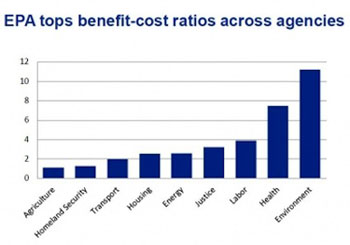by Rona Fried
Hopefully Congress will shed their partisan attack on the EPA for a moment and give the agency credit for our cleaner, more breathable air.
In a report to Congress, EPA shows that urban areas have much cleaner air since the Clean Air Act was strengthened in 1990.
According to EPA’s Urban Air Toxics Report, people that live in cities are exposed to 66% less benzene, 60% less mercury; 84% less lead.
EPA estimates that 3 million tons of air toxins have been eliminated, such as arsenic, benzene, lead and nickel from both stationary sources (ie., power plants) and mobile sources (ie, cars). These hazardous air pollutants (HAPs) are known or suspected carcinogens and can damage people’s immune, respiratory, neurological, reproductive and developmental systems.
Another 3 million tons of sulfur dioxide and particulates have been eliminated from power plants and car/truck exhaust.

EPA is making sure environmental justice is addressed by working with state, local and tribal agencies on regional strategies that zero in on the most affected communities.
In Indianapolis, for example, an EPA grant – "Building Lead Safe Communities" targets certain neighborhoods where there’s a high risk of lead exposure in children. Through air samples and a block- by-block analysis of lead in the soil, they can identify hotspots and solutions.
There’s still a long way to go in getting air toxics to safe levels and EPA has had to fight for each new regulation in numerous court cases:
- 2007 Mobile Source Air Toxics rule – cuts emissions from highway vehicles and off-road equipment that are known or suspected carcinogens – 330,000 tons less by 2030, including 61,000 tons of benzene, and 1 million tons of VOC emissions.
- Emissions from Cement Manufacturing – the third largest source air-borne mercury, this rule also cuts particle pollution and other pollutants.
- Sulfur emissions from power plants and industrial facilities.
- 2011
Mercury and Air Toxics Standard – lowers mercury levels 90% from coal-fired power plants by requiring the dirtiest power plants to install pollution prevention technology. - 2011 Cross-State Pollution rule – regulate emissions that travel from coal-heavy states in the Midwest and Appalachia to eastern states that have cleaner air. It cuts sulfur dioxide emissions by 73% (from 2005 levels) and nitrogen oxide emissions by 54%.
- Proposed updates to emission standards for petroleum
refineries – would reduce emissions from the 150 petroleum refineries across the US: 5600 tons a year of chemicals such as benzene, toluene and xylene. Many of these plants are close to communities. - Proposed rules on air pollution from fracking – would require methane capture and sale, and would cut smog-forming volatile organic compound (VOC) emissions.
- Proposed rules to cut methane emissions from landfills, requiring them to capture two-thirds of methane and air toxics by 2023 (13% more than current rules).
- Stronger emissions standards for cars and trucks go into effect in 2017 – will cut smog-forming VOCs and nitrogen oxides 80%; particulates by 70%; virtually eliminate fuel vapors emissions; sulfur by 60% and air pollutants such as benzene by 30% – at a cost of less than a penny per gallon of gasoline.
- Renewable fuel standard (RFS) – allows natural gas from landfills, biogas from wastewater treatment facilities and farms, and separated municipal waste to qualify as renewable fuels; among other changes.
- Last but not least are EPA’s proposed rules to bring down carbon emissions from power plants, which will be subject to endless court battles.
In terms of water pollution, Federal Appeals Court ruled in favor of EPA’s rule that sets water quality standards in rivers impacted by mountaintop removal coal mining. In another case, the court discarded President GW Bush’s rule, which repealed an 1983 requirement that coal companies must leave a measly 100-foot buffer between mining operations and waterways.
Read our article, Environmental Protection Agency Ranked Most Effective of All Federal Agencies.
More information on the Urban Air Toxics Report report:

..Thank-You EPA!